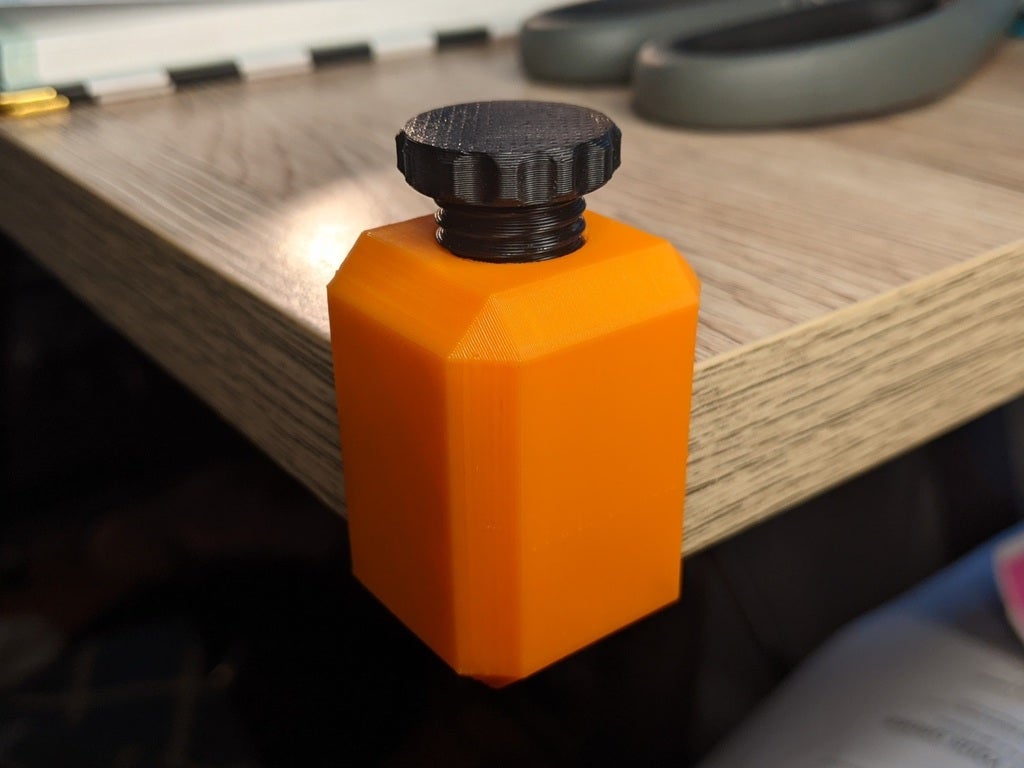
Adjustable Table / Desk Corner Guard Protector
prusaprinters
<p>Constantly getting poked by your desk's corners?</p><p>Scratched by your dinner table's edges?</p><p>Well, here's a simple 3D print for dealing those sharp corners! The guard can even be used to add a custom decorative flair to existing tables or desks. This design incorporates a few great features while consisting of only <i>three</i> easy to print parts!</p><p>This adjustable corner guard uses a 3D-printed screw to accommodate many different table thicknesses, while still providing an effective clamping force. The guard also incorporates a platform that distributes the screw's pressure over a larger area, thus preventing damage to the table's surface. And the best part: it's 100% 3D printed!</p><h4>Sizing</h4><p>The size of each component is specified in the STL filenames. By choosing the proper size base and screw, you can create corner guards for many table sizes. I recommend using the smallest applicable measurements when assembling your own guards as it's more compact and looks cleaner.</p><p>The maximum table thickness is simply the size of the base. For example, a <strong>35 mm</strong> base could fit a table that's <strong>35 mm</strong> thick at most.</p><p>The minimum table thickness is the base size minus the screw size. For example, a <strong>35 mm</strong> base and a <strong>15 mm</strong> screw could fit a table that's <strong>20 mm</strong> thin.</p><p>My basic rule is to measure the table and round up to the nearest multiple of 5. Then, I print that base size and pair it with a (previously printed) <strong>5 mm</strong> screw and pressure pad.</p><p>Lastly, the size in the filename is not the actual physical size of the part. A <strong>15 mm</strong> screw is actually <strong>26 mm</strong>, and a <strong>35 mm</strong> base is actually <strong>46 mm</strong>. The measurement is present only to make sizing the corner guard easier.</p><h4>Filament</h4><p>This was tested with PLA and PLA+, and both worked perfectly. The threads of the PLA print did show some wear after testing, which will impact the life of the print. <i>Oh no</i>, I guess you'll just have to print another...</p><p>Additionally, make sure your temperature is set correctly for your filament. If the temperature is too cold, then the poor layer adhesion will weaken the print. If the temperature is too hot, then the deformations can interfere with the screw hole's threads.</p><h4>Printing</h4><ul><li>Nozzle: 0.4 mm</li><li>Layer Height: 0.2 mm</li><li>Infill: at least 15%, but I recommend 25%</li><li>Vertical Shells: 3</li><li>Top/Bottom Layers: 5</li><li>Supports: No</li></ul><p>Print your choice base, your choice screw, and the pressure pad.</p><p>If you're printing multiple guards, I suggest doing each part as a separate print (all bases, all screws…). I'm not sure exactly why, but the quality is vastly different.</p><h4>Assembly</h4><ol><li>Twist the screw in to the base. It can be difficult the first time, but you'll only ever need to do this once.</li><li>Work the screw back and forth a few times. Tighten until at least 4 mm of the screw have emerged inside the base.</li><li>Line up the pad's pegs with the hole in the end of the screw. <strong>PROTIP</strong><i>:</i> The part of the pad that looks "cut off" should be far away from the screw.</li><li>Snap the pad in to the screw. This takes quite a bit of force, so channel-lock pliers might help. </li><li>Make sure the screw can move freely and the pressure pad isn't restricted. If everything looks good, you're ready to install it!</li></ol><h4>Installation</h4><ol><li>Loosen screw to fully open the guard. <strong>Do not loosen the screw all the way out of the base!</strong> Doing so can break the pegs off of the pressure pad.</li><li>Place assembly over a corner. The orientation of the screw doesn't matter, but I find the screw facing "up" is more convenient.</li><li>Twist the screw head until base grips the corner securely. <strong>Do not over tighten!</strong> The screw can provide a lot of force, which can potentially damage your table despite the pressure pad.</li></ol>
With this file you will be able to print Adjustable Table / Desk Corner Guard Protector with your 3D printer. Click on the button and save the file on your computer to work, edit or customize your design. You can also find more 3D designs for printers on Adjustable Table / Desk Corner Guard Protector.
